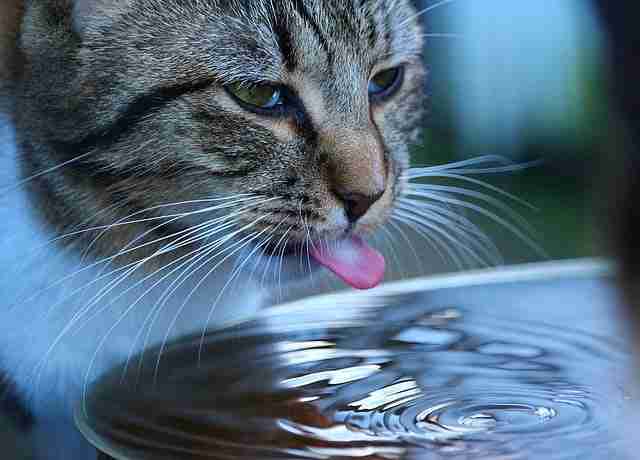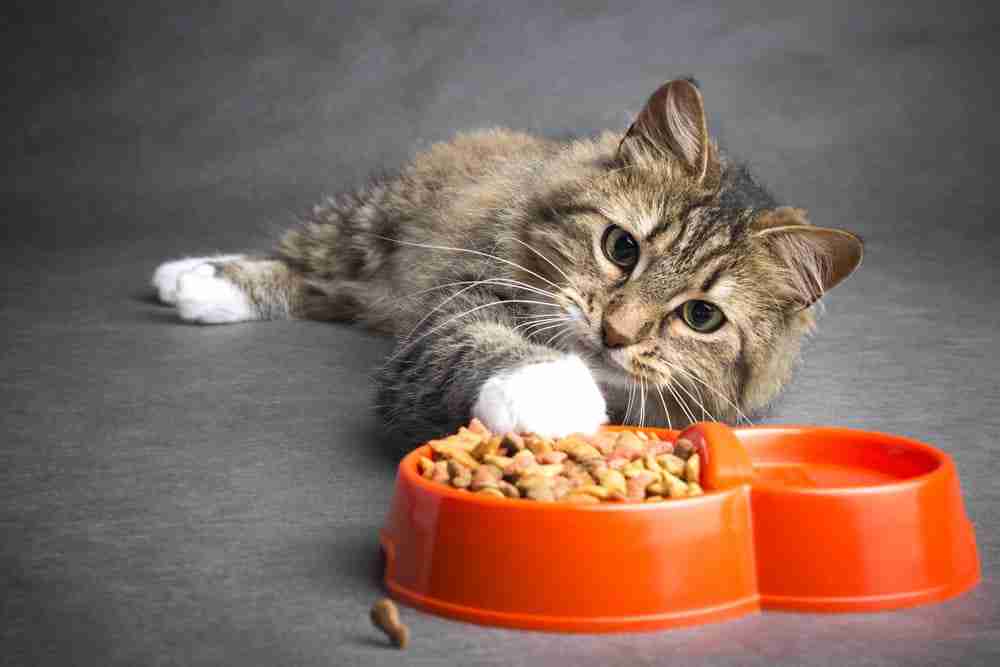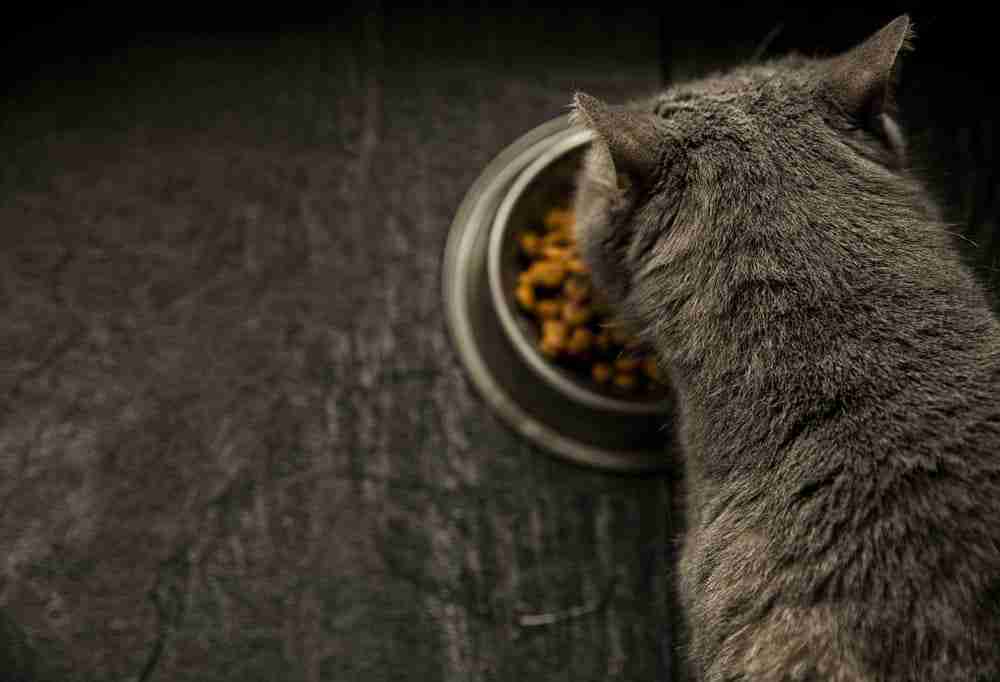Water is a vital part of a cats’ nutrition. Without it, all sorts of bad things can occur very quickly. How long can a cat go without water? Not long! You might suspect that your cat, living on a dry food diet, does not get enough water. The truth is, you are probably correct! Cats that live in the wild and hunt usually get 70% – 80% of their water from the food they eat. The dry food you serve up probably has less than 15% moisture included. That is a big shortfall! So, a reasonable question for the caring cat owner who wants to keep their cat on dry food but also wants to boost their water intake or make sure they get the moisture they need is “should I wet my cats dry food?”
Should I Add Water To Dry Cat Food?
Why not? There are some big advantages to wetting up dry cat food. Let’s take a look at some of the obvious and less obvious reasons that your kitty should probably be eating dry food with water added.
Increases Water Intake
When choosing between wet or dry cat food moisture intake, from a health perspective, is a big factor. It is the obvious reason for adding water to dry cat food. You really want to boost water intake so that their intake is as close to that of a cat in the wild as possible. You might ask why bother? Well, when that water intake drops below what the cat has evolved through thousands of years of development to absorb, you get a whole host of crappy situations happening to your cat health-wise.
The common problems with a lack of water in a cat’s diet that you want to avoid include dehydration, urine crystals, and sluggish digestion. They don’t seem that bad at first glance so let’s dive in and see just what we are talking about here.

Dehydration. Basically, a dehydrated cat can die from organ failure within 24 – 48 hours. That is how serious this condition is. Now, generally, it is the old and sick cats that get dehydrated this bad – think vomiting cats or cats with diarrhea. But a cat that has persistently poor water intake is going to do itself damage. The problem is they don’t really have a very good thirst mechanism and are evolved to take moisture through food, so a cat on dry food might not realize till too late that it is getting dehydrated and entering the danger zone!
You can check the state of dehydration in your cat by doing the pinch test. You basically pinch the skin between the shoulder blades and if it doesn’t ping back straight away or tents up instead with no elastic recovery your cat is dehydrated and needs more water.
One of the main problems with dehydration is kidney damage. A short, sharp bout of dehydration can lead to damage that can be life-threatening in the short term but over the longer term, such kidney damage can shorten the cat’s lifespan, forcing dietary changes and reduce the quality of life.
Urine Crystals. This is actually a really simple concept to grasp. Less water through the pipes leads to highly concentrated urine in the bladder that can form crystals instead of a salty solution. Aforesaid crystals then block up drainage causing great pain and potentially bladder bursts. Outcome – expensive surgery and specially formulated expensive diets for life or at least wet food for life – I know this, I have been there! All are potentially alleviated by dodging the dry diet option (although sometimes it is just the way your cat is built).
Admittedly, this problem is more common in male cats due to the length and diameter of the urethral opening but can happen to cats of either sex.
Constipation. A lack of water in the diet can lead to constipation. So what, you might say. Well, with cats grooming themselves and absorbing lots of hair, constipation is a problem. If you can’t get rid of the hair, through normal passage shall we say, then it has to come out the other way as hairballs! Now every cat has a hairball from time to time. It is no big deal. But if your cat is an indoor, long-haired cat with constipation you are probably going to get more than your fair share of hairballs!
In all seriousness, hairballs to excess can be bad. Your cat may feel full the whole time, go off their food, and then start to lose weight or worse, not eat and develop liver problems from not eating!
Slow Down Fast Eaters
Fast eating is a problem because it usually ends up with your cat throwing up. And then you clean up! Apart from that, there is no problem! Not really, if your cat is not eating right they will lose weight or demand more food resulting in the bills going up having some out half the food you bought.
You could go down the route of making it harder for them to access the food with puzzle feeders, slow feeder cat bowls, or timed feeders. Alternatively, you could try wetting up the kibble and slowing them down that way! Winner, winner, chicken dinner! Costs barely anything and works a treat.

Reduce Bloat
When your cat eats dry food and the dry food hits a wet stomach the kibble may absorb the moisture in the stomach and expand. The end result is that your cat feels bloated, gassy, and ends up throwing up. Now, this doesn’t happen with all dry kibbles but a quick way to test the kibble you use is to add some water and see if the kibble grows before your eyes. If it does, imagine how your cat feels when they eat it!
You can reduce bloat and vomiting by adding water to dry cat food first and expanding that kibble so when your cat eats it feels full at the appropriate time and then stops overeating.
Increases Appetite
Maybe you haven’t got a fast-eating problem or an overeating problem? Maybe you got the opposite issue. Your cat doesn’t eat enough. Little bugger just isn’t interested. Got you all worried about the skinny wretch fading away?
How about trying this. Add water. Not cold water. Lukewarm water. The effect should be that the texture, flavor, and aromas develop into something more interesting than your usual bang average dried cardboard kibble. If your cat licks food but doesnt eat then the aroma may be ok but the flavor or texture could be a problem.
Some cats are really picky and just won’t eat something too dry, too hard, the wrong temperature, or something that doesn’t smell top notch – can’t say I blame them – who likes a flavorless meal or fries served cold? Cold chinese…no thanks. Same for your cat – add water to see if you can tempt them.
How Much Water To Add?
Ok, so we have identified that there are some big benefits to wetting up your cat’s dry food but let’s look at practicalities. How do you actually do it?
A cat eating wet food would normally get a lot of moisture from the wet food. Most wet foods contain 80% moisture which replicates the moisture content of the cat’s natural diet. A cat eating wet food may only need an additional 30ml of water per day on top of their wet food intake. Even on a wet food diet they still need a clean freshwater supply.
A cat on dry kibble may need as much as 200ml additional water just to take on board the same amount of moisture as that found in wet food!
To boost a cat’s water supply, improve the texture and aroma of the food, slow down eating but still make the food appetizing you should add about ¼ cup(60ml) of water to each helping. This water should be warm but not hot – this will enhance the flavor. The idea isn’t to create a soup but to soak that kibble so it starts to fall apart and lose form.
A typical, dry food instruction might be to feed a 12lb cat ⅔ of a cup of kibble per day (Iams). You might put this out in three helpings. So a third of a cup per meal. If you add 60ml of water per meal you are going to come far closer to the moisture content of a wet diet. You will notice though that it is never going to be the same as feeding wet food. If you try to add too much water the food will just dissolve into a watery mess! If your cat turns their nose up at damp kibble try moistening the food with tuna juice. Most cats find this irresistible!

Reasons Not To Wet Up Kibble?
Unfortunately, it is not all good news. There are some pretty convincing reasons why you should not wet up dry cat food.
The main issue is that some dry foods may harbor bacteria and fungus. Whilst the food is dry you don’t have to be overly concerned about their presence. When you wet food up and leave the food out for too long, particularly in warmer conditions, the bacteria and fungi could multiply and bloom creating health issues for your cat if the cat ingests these contaminants in too greater quantity.
What to do? If you wet up the kibble make sure you don’t leave it out for more than half an hour. This way the risks can be minimized. But, I hear you say, that defeats the point of dry food. You want your cat to eat dry food so it can be left out all day without going rank. This is the problem with wetting up dry food. It is not the best food to feed your cat if you want your cat to get more moisture in their diet. The benefits of dry food arise because the moisture is removed!
A secondary issue with wetting up dry cat food is that it just creates a right mess. I am sure some people don’t feed wet food because the remains are often rank and cleaning the bowl is tiresome if you don’t throw it in a dishwasher. Well, you got the same problem with dry food that is moistened. It dries onto the bowl-like old cornflakes turning to concrete and is just as inconvenient to clean up as stale wet food.
The choice is yours. Add water to dry cat food to boost your cat’s moisture intake but don’t leave that stuff out too long or in too large an amount that the dry cat food goes bad or turns to concrete OR just bite the bullet and move to a wet food diet (which is massively more healthy for your cat anyway).
